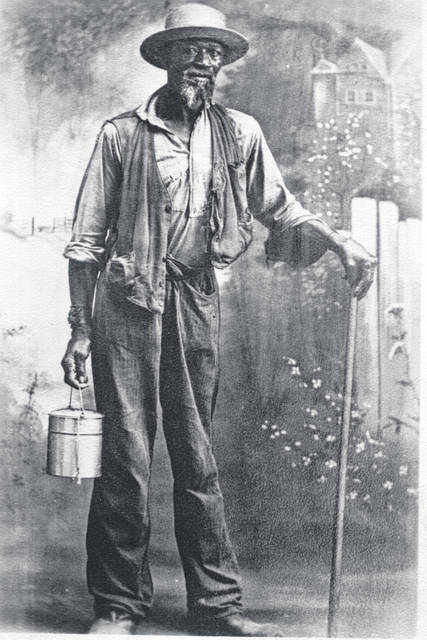


Editor’s note: in conjunction with the 200th celebration of the establishment of Sidney, the Sidney Daily News will be publishing a year long series about the city’s history.
SIDNEY — Known as the land of plenty, America offers freedom and opportunity to those who journey here. However, for the people brought to this country as slaves, the American dream was replaced by oppression, poverty and indignities. In 1803, Ohio became the first state carved out of the Northwest Territory where the ownership of slaves was not permitted, yet laws were passed in 1804 prohibiting blacks from serving on juries or testifying against whites. Blacks could not settle in Ohio without a certificate of freedom, and those here must register and pay 12 1/2 cents. In 1807, blacks had to post a $500 bond, significantly limiting migration. The first documented black man in Shelby County was in the early 1820s when William Roberts moved to Salem Township to grant his slaves their freedom. One chose to stay with the family and worked as a paid employee on their homestead.
John Randolph and His Slaves
Virginian John Randolph was a wealthy politician who left three wills, two of which freed his slaves, “I give and bequeath to all my slaves their freedom, heartily regretting that I have ever been the owner of one.” He left $8,000 for transporting/settling his slaves and those over the age of 40 would receive 10 acres of land.
Claiming that John was insane, his brother contested the will and 13 years passed before the courts would honor it. Randolph’s cousin, William Leigh, then traveled to Mercer County where he bought 3,200 acres for $6,000. In June 1846, 383 former Randolph slaves and wagon master Cardwell loaded 16 wagons heading 500 miles to Ohio. Their ages ranged from that of an infant to 100 year old Granny Hannah.
Their certificate of freedom stated, “…A true list and description of the emancipated slaves…made out from the general book of registers of free Negroes and Mulatoes (sic).” The document listed all their names and according to Piqua historian Helen Gilmore, “They examined them from head to toe and wrote down any marks you had on you…made you feel like you was cattle or pigs. Every slave had a number.” Included on the 12 page list was No. 514 – Shadrach, who would take White as a surname (later known as Buddie Shang) and No. 421 – Carter – a man of black complexion, aged 33 years, 5’ 9 ½.” (A slave did not have a last name until freed and would often take the name of his/her ‘master,’ residence or of some famous person).
Randolph Slaves Arrive in Ohio
The slaves boarded Miami & Erie Canal barges in Cincinnati heading to Mercer County. A Dayton newspaper reported, “Some of them regretted being compelled to leave Virginia…a great deal of opposition has been manifested by the Mercer County citizens, and resolutions were passed to prevent these Negroes from coming.”
In Piqua, the travelers were not allowed access to water and the barges moved into Shelby County, passing through the Lockington locks, on to Berlin/Fort Loramie where they were not allowed to land, and New Bremen/Mercer County. They were greeted by an armed mob of whites, “Resolved, we will not live among Negroes; as we have settled here first… we will resist the settlement of blacks and mulattoes in this county to the full extent of our means.”
The blacks left on canal boats, disembarking in Miami County (Rossville) where whites brought them food. They would later locate in Sidney, Troy and other communities. Sidney newspaper, Aurora condemned the selling of land and pocketing “a large amount of money for provisions not two weeks before the arrival of the poor creatures whom they so unjustly treated.”
Some headed for Sidney/Shelby County said a Piqua newspaper, “…last week an effort was made to settle them in Shelby County, but like the attempt in Mercer it failed…driven away by threatened violence.” Former slave Clem Clay told how local citizens eventually decided to allow a number of them to stay in Sidney: “A good class of white people took some on the farm and some to houses…”
In 1900, the Randolph Ex-Slaves Association was formed and 62 of the original ‘Old Dominions’ (born into Virginia slavery and transported to Ohio) were present. (The ‘Buckeyes’ were born in Ohio). Up to 300 people attended reunions in Piqua, Troy and at the Shelby County Fairgrounds.
Plunkett, a man trusted to represent the slaves, sold the unclaimed land in the 1840’s for $7,700. In 1907, approximately 170 of the former Randolph slaves unsuccessfully filed 27 cases to recover the land willed to them, or its $38,000 value. The cases lasted a decade and went all the way to the United States Supreme Court.
The Underground Railroad
Ohio’s Underground Railroad was a network of routes and stations/safe houses where blacks could stay while traveling north. Two trails entered Shelby County from the south, one split following the Miami & Erie Canal while a third trail passed through Sidney to the east and west.
Mount Vernon Baptist Church
Gospel songs indicated how escapes would occur on the Underground Railroad. ‘Follow the Drinking Gourd’ referred to the North Star/Big Dipper. The Mt. Vernon Baptist Church began in the homes of two Randolph slaves in 1846 – Roger Lee and Frank Brown. A circuit rider minister assisted in creating a new church and the first building was constructed on a lot now occupied by the Monarch Community Center.
Education
An 1853 state law established schools for colored children. A separate school was built for them in 1878 and abandoned in 1895 as the ‘Black Laws’ had been repealed. “There are sixteen schools in all…one colored school.” The 1885 Sidney Journal reported, “Teacher of the Negro school is sick… no school.”
The Civil War (1861-1865)
In 1863, President Lincoln’s Emancipation Proclamation led Sidney’s Elias Artis and Hezekiah Stewart to join the 54th Massachusetts Black Volunteer Infantry. Although many died in battle, both men are thought to have survived the Civil War and their names are listed, among 324 veterans, on the tablets in Sidney’s Monumental Building.
World War I (1914-1918)
Almost 400,000 blacks served in the military’s segregated units and a 1918 Sidney Daily News article featured five men, “…the colored people of the county had turned out to wish the boys God speed in their answer to their country’s call. As the men came out of the Court House they formed lines honoring the boys as they passed through. The colored people, then proceeded by the Sidney band, marched to the B. & O. station…An immense crowd (white and black) was at the station…””
1930s – 1960s
The plight of blacks was captured in the Depression-era slogan, “Last Hired and First Fired.” In 1948, President Truman desegregated the nation’s armed forces. Court rulings addressed education and housing where discrimination and segregation still festered. ‘Jim Crow’ signs were posted in the 50’s/60’s segregating blacks from whites. These laws were based on the Supreme Court’s 1896 decision ruling blacks accept separate accommodations as long as they were “equal”. ‘For White Only’ signs appeared in businesses across the nation.
Ku Klux Klan
The KKK, a group of white secret societies, traces its roots to a group of Confederate veterans organized to oppose minorities. With concealed identities, they often beat and murdered, burning crosses to intimidate blacks.
Sidney Daily News April 28, 1923: “We have waited a week in regard to the demonstration of the KKK in our village (Anna). The citizens are pretty much wrought up over the affair. About 95 per cent against such demonstrations.” On May 16, 1923, a cross was burned in East Sidney (Brooklyn Avenue).
Harry Miller worked as a conductor and brakeman for the Western Ohio Traction Company from 1917 to 1929. He recounted for the local paper how he worked the ‘Ku Klux Klan’ car which made trips from Sidney to the St. Mary’s/Celina area in the 1920’s.
NAACP
NAACP, a national civil rights organization that works to end discrimination against blacks and minority groups, was founded in 1909. Major successes included the Civil Rights Acts of 1957/1964, and the Voting Rights Act of 1965. Consulting with black and white residents, Frank O’Leary created a Sidney chapter of the NAACP in 1965. Fifty members were required and the founders included Carl King, Rufus Sims, Harrison Brown, James Daniel and Lucille King. The organization’s initial mission was workplace discrimination that existed within some Shelby County industries. In 1971, the chapter became the Ohio Tri-County NAACP serving Shelby, Miami, and Logan counties.
James P. Humphrey – First Black Mayor of Sidney
A descendent of the Randolph Slaves, Sidney’s first black mayor, James (Jim) Humphrey was a lifelong resident that gave significant amounts of time trying to preserve the tragic saga of the Randolph slaves. Born in 1921, Jim was a World War II veteran and served in city government as councilman-at large, vice mayor and mayor (1981-1987). He was a deacon of the Mt. Vernon Baptist Church for over 40 years and involved in community organizations such as the Salvation Army, NAACP and the Sunset Kiwanis. He was included in “Who’s Who Among Black Americans” and honored in 1987 with the establishment of a scholarship fund in his name. Scholarships are awarded each year to black Shelby County students as incentives for achievement and has provided over $246,000 to 172 Sidney/Shelby County graduates. The funds are awarded in recognition of Humphrey’s commitment to excellence in education, black history, community service and his deep dedication to religious beliefs. He earned countless honors, including Black Mayor of the Year for Ohio, Sidney’s Black Achiever of the Year, Man of the Year, Outstanding Senior Citizen in Shelby County, etc. Jim was a tremendous advocate for black history and talked passionately of the struggles that he and others suffered during earlier years.




